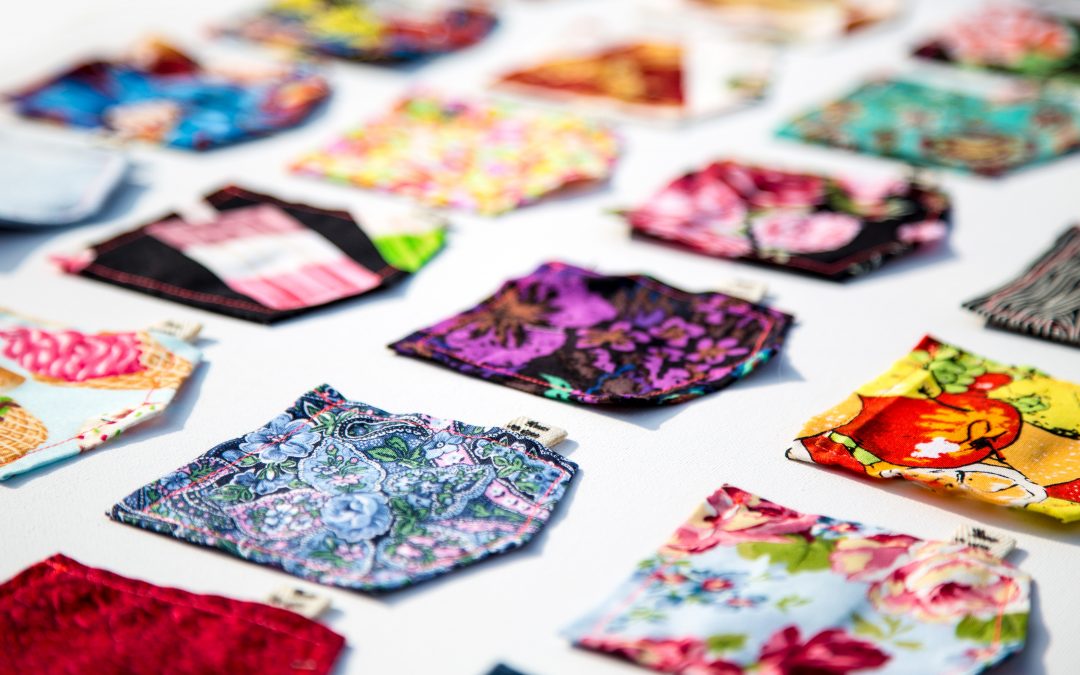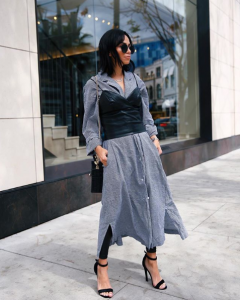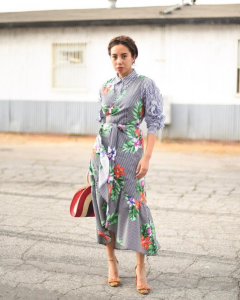
by Kosher Casual Team | May 31, 2018 | Uncategorized
One of the latest fashion trends is one we at Kosher Casual are very familiar with! It’s all about layering.
The latest layering craze takes it to the next level as it emphasizes pairing contrasting patterns and styles to make a real statement. Kosher Casual has also added some great patterned tops, dresses, and skirts to play with in your personal layering experimenting.
Stay tuned to our Instagram to see each new piece as it comes in and in the meantime, enjoy these Instagrammers for inspiration.
@rachelleyadegar @veronicaslook


For those more conservative fashionistas, Kosher Casual always has a huge collection of fashion basics in solids with a great selection of layering options as well. Our popular layering dress is an essential piece for the modern and modest dresser. We’d love to see some of your layering outfits, so please share with us below!

by Kosher Casual Team | May 16, 2018 | Uncategorized
The internet is raging with the new “Yanny vs. Laurel” debate (original tweet), and we couldn’t help but see a very clear and important life lesson in it. How can some people clearly hear Laurel and others hear Yanny?
This audio debate is even more perplexing than the blue vs. gold dress arguments that flooded the internet several years ago. The explanations for this audio based discussion can and have been attributed to bass or pitch levels as seen here by ten different experts. While their arguments makes sense in theory, the distinction in the devices’ output becomes irrelevant when several participants are listening to the audio clip on the same device.
As a clothing brand in the modest fashion industry, we often get questions (and criticism) from customers about how long our hemlines are or whether our neckline options are more or less modest. Our response is that Kosher Casual is an advocate of modest clothing in all of its definitions without judgment and tries to offer options for the range of needs. What we have learned from our customers and from listening to our community is that modesty doesn’t come in a single definition. There are many standards about what modesty is and how to dress modestly. Even our Jewish, Christian, Muslim, and secular customers have a wide range of criteria within the same groups.
As in the audio clip, people hear, see, and experience things from their own perspective. Their past experiences and their unique physiological makeup affect how they interpret situations and sounds! While you may hear one thing, it is very possible for your friend or spouse to hear something completely different. The same difference in perception goes for the idea of modesty as well.
Modesty perspective is an individual choice that is developed on individual experience and culture. Members of the same sects of faith may feel that the way one behaves is more important than the way one dresses. Others disagree. Both opinions are valid, just like the Laurel and Yanny debate. When we see and accept that the world is made up of all different types of people with different experiences and ideals, then we can really start to understand how and why our difference are not only valid but important. So next time we are quick to call someone else’s idea of modest, immodest, or someone’s choice to cover up more, a zealot, remember that their choice is their most truthful idea of modesty. Let us embrace their intent.
Whatever drives you to dress modest, we applaud your effort in making getting dressed every morning, meaningful.

by Kosher Casual Team | Apr 30, 2018 | Uncategorized
Here in Israel spring is short and summer is hot! Kosher Casual is located in Beit Shemesh, where it is really hot…no, really, really, really hot. Therefore, we start to feel the summer modest challenge early and we seek to provide solutions that will last the entire summer.
While some commercial fashion was showing more modest necklines and hemlines, in the summer those influences start to fade. Most stores won’t carry options for modest dressers. The pressure to find the right clothing is on.
In addition to Kosher Casual offering you real modest choices, we’re here to also offer you encouragement and hope for getting through the summer without sacrificing your values or fashion sensibilities!
1. Plan – Start looking for modest clothing options now so that you have a few tops or dresses to choose from. Once the summer rolls in, the stores will have less and less long sleeved shirts and full length dresses. Treat yourself to a dress you love in more than one color.
2. Invest – Find a water bottle that keeps your water colder and for longer periods. Pay a little more for this feature if you know it will help keep you cool.
3. Support – Grab a friend and kvetch a little! There’s no shame in acknowledging the struggle. Choose a friend that you know understands how uncomfortable the hot weather makes you and be a support to each other.
4. Get Involved – Places like Instagram have loads of people sharing how they stay modest by taking pictures of their cute, modest and summer friendly outfits. You can get involved in the online modest fashion community and see that you aren’t alone in sticking to what you believe!
Hopefully, these tips will help get you through the summer! We encourage you to seek out ways to be adorable while staying modesty. And because you’re not alone, share in the comments below how you manage to stay
modest and cool!

by Kosher Casual Team | Jan 2, 2018 | Exercise Outfits, Holiday Shopping, Holidays, workout clothing
It’s that time of year again, when some of us are inspired to make the coming year, a better one. Some of us are tired of setting lofty goals only to see ourselves fail come February. Well, it’s easy to be critical of the New Year’s Resolution, but at Kosher Casual, we salute the effort and intention! Therefore, we’ve put together some ideas on how to help you achieve your New Year’s Resolutions.
- Choose ONE resolution. There are so many ways each and every one can “improve”, but the best way to climb the mountain is to just choose one mountain. This year prioritize your goals and identify the one that is most frustrating and most achievable, the one that drives you the craziest.
- If you didn’t choose a New Year’s Resolution, it’s not too late! Just because New Year’s Eve has come and gone, doesn’t mean the chance at self-improvement has too. Take some time and make that difference starting immediately.
- Stay away from previous “resolutions”. This year tackle something new, something that won’t make it easy to fall into the same habit of giving up. Choose something that can change your life today and will encourage you to take on previous resolutions once you’ve achieved and devoured this one.
- A New Year’s Resolution is personal. Don’t base your goal on what your friends, coworkers and family are doing. This resolution is about you, so dig deep and get personal.
- Outline the steps. Make this resolution attainable by setting time-based steps. Create levels of growth and focus on one part at a time. Often, when you can visualize the entire path, reaching the finish line is more feasible.
- Share your resolution. Tell your friends and family what your resolution is so as to make yourself accountable. By offering this information to your everyday peers, they can help to encourage and keep you on track.
- Remind yourself why you’re doing this. Add mental reminders a part of your morning routine. Wakeup, brush your teeth, tell the girl in the mirror that today is the day! If morning groggy head gets in the way, get sticky notes and add them to your path through the house.
- Add a reward system. Remember those new pointy flats you wanted so badly, well, their yours if you get halfway to destination resolution
- Pick up the pencil and make it concrete. Writing out your plans and goals will make it more real and help you focus on each step without getting overwhelmed by the overall goal.
- Finally, expect to falter. Allow yourself setbacks and don’t let them throw you off the deep-end. When you allow yourself to be human and recognize that it’s part of the process, you are less likely to quit.
So whether you’re finally going to tackle that nail biting habit or make journaling a regular part of your day, know that we’re rooting for you!
Happy New Year from the Kosher Casual Team!
* In the event your New Year’s resolution has anything to do with fitness, check out our line of modest workout gear! Skirts with leggings attached at different lengths and color combinations, see it here.

by Kosher Casual Team | Nov 22, 2017 | Uncategorized
Black Friday is once again upon us and everyone likes to get a good deal. Many people will hold off on a big purchase until Black Friday to get the “best” deal. At Kosher Casual, we are on board for the action as well, but from the other side of the checkout counter, the seller’s side!
We wanted to share some tips we have learned over the years to help you get the best deals and walk away happy.
#1 Take advantage of retailers with online stores
This tip is fairly obvious because the biggest benefit is the ability to avoid the chaos of waiting in line, digging through racks or shelves. Getting to the store after finally finding a parking spot, just to learn the product you came for is out of stock! Some retailers even offer Black Friday discounts online a few days before Black Friday. This leads us to our next tip…
#2 When you have an item at discount in your shopping cart, buy it!
Do not hesitate or wait until Friday if you are already seeing a discount in your cart, there is a strong likelihood that the item you want could sell out. So do not wait days to buy, if the site says Black Friday discount, it’s likely that the prices won’t go down much more.
#3 Plan accordingly using a retailers website
This tip is for items that are only available at in-store sales. In order to make the most out of Black Friday, it is best to prioritize the items you plan to buy on Black Friday. Use a retailer website to organize by store hours and locations. Choose the items that you absolutely need and get those first, Black Friday is not the day to roam or browse your favorite stores.
#4 Shop with a friend
By bringing a friend along, you can help each other accomplish more. Perhaps there is a long line in one store, one person can stand in line while the other checks out items that were lower on the priority list. More importantly than that, Black Friday shopping can be exhausting and frustrating, bringing a friend can help you both laugh off the quirky situations that come with big sales.
#5 Don’t go to Walmart 😉
This one does not need so much explanation so I’ll just leave you with this…

Happy Holidays!








